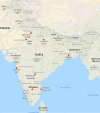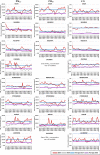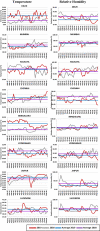COVID-19 lockdown: a boon in boosting the air quality of major Indian Metropolitan Cities
- PMID: 33223600
- PMCID: PMC7671670
- DOI: 10.1007/s10453-020-09673-5
COVID-19 lockdown: a boon in boosting the air quality of major Indian Metropolitan Cities
Abstract
Abstract: The COVID-19 lockdown has not only helped in combating the community transmission of SARS-CoV-2 but also improved air quality in a very emphatic manner in most of the countries. In India, the first phase of COVID-19 lockdown came into force on March 25, 2020, which was later continued in the next phases. The purpose of this study was to investigate the result of lockdown on air quality of major metropolitan cities-Delhi, Mumbai, Kolkata, Chennai, Bengaluru, Hyderabad, Jaipur, and Lucknow-from March 25 to May 3, 2020. For this study, the concentration of six criteria air pollutants (PM2.5, PM10, CO, NO2, SO2, and O3) and air quality index during the COVID-19 lockdown period was compared with the same period of the previous year 2019. The results indicate a substantial improvement in air quality with a drastic decrease in the concentration of PM2.5, PM10, CO, and NO2, while there is a moderate reduction in SO2 and O3 concentration. During the lockdown period, the maximum reduction in the concentration of PM2.5, PM10, CO, NO2, SO2, and O3 was observed to be - 49% (Lucknow), - 57% (Delhi), - 75% (Mumbai), - 68% (Kolkata), - 48% (Mumbai), and - 29% (Hyderabad), respectively. The value of the air quality index (AQI) also dwindled significantly during the COVID-19 lockdown period. The maximum decline in AQI was observed - 52% in Bengaluru and Lucknow. The order of AQI was satisfactory > moderate > good > poor and the frequency order of prominent pollutants was O3 > PM10 > PM2.5 > CO > NO2 > SO2 during the lockdown period in all the aforementioned metropolitan cities.
Keywords: Air quality index; COVID-19; Criteria pollutants; Lockdown; Metropolitan cities; Prominent pollutant.
© Springer Nature B.V. 2020.
Conflict of interest statement
Conflict of interestThe authors declare that they have no known competing financial interests or personal relationships that could have appeared to influence the work reported in this paper.
Figures







Similar articles
-
Pandemic induced lockdown as a boon to the Environment: trends in air pollution concentration across India.Asia Pac J Atmos Sci. 2021;57(4):741-756. doi: 10.1007/s13143-021-00232-7. Epub 2021 Feb 1. Asia Pac J Atmos Sci. 2021. PMID: 33552402 Free PMC article.
-
COVID-19's lockdown effect on air quality in Indian cities using air quality zonal modeling.Urban Clim. 2021 Mar;36:100802. doi: 10.1016/j.uclim.2021.100802. Epub 2021 Feb 12. Urban Clim. 2021. PMID: 36569424 Free PMC article.
-
Effects of COVID-19 pandemic on the air quality of three megacities in India.Atmos Res. 2021 Sep;259:105659. doi: 10.1016/j.atmosres.2021.105659. Epub 2021 May 1. Atmos Res. 2021. PMID: 36568528 Free PMC article.
-
COVID-19 lockdown and environmental pollution: an Indian multi-state investigation.Environ Monit Assess. 2022 Jan 3;194(2):49. doi: 10.1007/s10661-021-09693-9. Environ Monit Assess. 2022. PMID: 34978634 Free PMC article. Review.
-
The effect of COVID-19 pandemic on human mobility and ambient air quality around the world: A systematic review.Urban Clim. 2021 Jul;38:100888. doi: 10.1016/j.uclim.2021.100888. Epub 2021 Jun 18. Urban Clim. 2021. PMID: 36536793 Free PMC article. Review.
Cited by
-
Impact of COVID-19 lockdown and meteorology on the air quality of Srinagar city: A temperate climatic region in Kashmir Himalayas.Hyg Environ Health Adv. 2022 Dec;4:100025. doi: 10.1016/j.heha.2022.100025. Epub 2022 Sep 15. Hyg Environ Health Adv. 2022. PMID: 37520075 Free PMC article.
-
Change in the air due to the coronavirus outbreak in four major cities of India: What do the statistics say?J Hazard Mater Adv. 2023 May;10:100325. doi: 10.1016/j.hazadv.2023.100325. Epub 2023 May 29. J Hazard Mater Adv. 2023. PMID: 37274946 Free PMC article.
References
-
- Burke RM, Midgley CM, Dratch A, Fenstersheib M, Haupt T, Holshue M, Ghinai I, Jarashow MC, Lo J, McPherson TD, Rudman S, Scott S, Hall AJ, Fry AM, Rolfes AM. Active monitoring of persons exposed to patients with confirmed COVID-19 United States. Morbidity and Mortality Weekly Report. 2020;1:1. doi: 10.15585/mmwr.mm6909e1externalicon. - DOI - PMC - PubMed
-
- Cadotte, M. (2020). Early Evidence that COVID-19 Government Policies Reduce Urban Air Pollution. 10.31223/osf.io/nhgj3.
-
- Chan J, Yuan S, Kok K, Kai Wang-To K, Chu H, Yang J, Xing F, Liu J, Yan Yip C, Shan Poon R, Tsoi H, Fai Lo S, Chan K, Man Poon V, Chan W, Daniel Ip J, Cai J, Cheng J, Cheng H, Hui C, Yuen K. A familial cluster of pneumonia associated with the 2019 novel coronavirus indicating person-to-person transmission: A study of as family cluster. Lancet. 2020 doi: 10.1016/S0140-6736(20)30154-9. - DOI - PMC - PubMed
LinkOut - more resources
Full Text Sources
Miscellaneous
